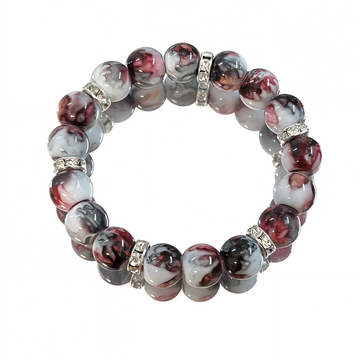When wearing a stone bracelet, if it is not stable enough, it is prone to slipping and turning, which will affect the wearing experience and safety. The following introduces tips for enhancing the wearing stability of stone bracelets from four aspects: size matching, wearing method, auxiliary tools, and daily maintenance:
Size adaptation
Accurately measure the wrist size: Use a flexible tape measure to wrap around the thinnest part of the wrist once. The data obtained is the wrist circumference. If you don't have a flexible measure, you can also wrap a thin string around your wrist once, mark the position, and then measure the length of the string with a ruler. When taking measurements, it is important to keep your wrist naturally relaxed and avoid deliberately tightening or relaxing the muscles to ensure the accuracy of the measurement results.
Choose a bracelet based on the size of your wrist: Generally speaking, the inner diameter of the bracelet should be 1 to 2 centimeters larger than the circumference of your wrist. This ensures that the bracelet can be worn smoothly without being too loose and prone to slipping off. If the inner diameter of the bracelet is too small, it will tighten the wrist, affect blood circulation and be uncomfortable to wear. If the inner diameter is too large, the bracelet is prone to shaking and slipping off.
Consider the thickness and width of the bracelet: Even if the inner diameter is appropriate, a thicker or wider bracelet may not feel stable enough when worn due to its weight and volume. For people with thinner wrists, it would be more appropriate to choose bracelets with moderate thickness and width. For those with thicker wrists, they can appropriately choose slightly thicker and wider styles, but they should also be careful not to make them too heavy to avoid increasing the burden of wearing.
Wearing method
Find the right wearing position: Put the bracelet on a relatively flat area below the wrist joint. At this position, the range of motion of the wrist is relatively small, and the bracelet is less likely to fall off due to external force interference. Avoid wearing the bracelet on the wrist joint or too close to the palm, as these areas have frequent wrist movements and the protruding joints may hinder the wearing of the bracelet and also easily cause it to be unstable.
Wear with the aid of lubricants: If the bracelet is difficult to wear, you can apply some mild lubricants on your wrist or the inner side of the bracelet, such as hand cream or olive oil. When applying, make sure it is even. Then gently put the bracelet on your wrist and slowly rotate and push it forward. Lubricants can reduce the friction between the bracelet and the wrist, making the wearing process smoother. At the same time, they can also enable the bracelet to fit the wrist better and enhance stability.
Adjust the wearing posture: When wearing a bracelet, try to keep your wrist straight and avoid excessive bending or twisting. After putting on the bracelet, you can gently move your wrist to let the bracelet naturally adapt to the shape of your wrist. If you find that the bracelet is misaligned or rotating, adjust it to the appropriate position in time.
Auxiliary tools
Use anti-slip washers: Anti-slip washers are auxiliary tools specially designed for bracelets, usually made of soft and elastic materials such as silicone. Put it on the inner side of the bracelet, which can increase the friction between the bracelet and the wrist and prevent the bracelet from sliding. Anti-slip washers are available in a variety of sizes and can be matched according to the inner diameter of the bracelet and the thickness of the wrist. When in use, place the gasket flat on the inner side of the bracelet, and be careful not to affect the appearance of the bracelet.
When wearing a stone bracelet, pair it with a suitable bracelet or bracelet. Bracelets or strings can be intertwined and fixed with bangles, providing a certain degree of stability. When choosing a bracelet or string, pay attention to its material and style being in harmony with the bracelet to avoid being overly complicated or conflicting. For instance, if the color of the stone bracelet is rather bright, you can choose a simple metal bracelet or a wooden bracelet to match.
Daily maintenance
Avoid vigorous exercise: When engaging in vigorous exercise, the wrist has a large range of motion, which can easily cause the bracelet to be hit or rubbed, leading to loosening or slipping. Therefore, when doing sports such as running, working out or playing ball games, it is best to take off the bracelet and place it in a safe place.
Regularly check the bracelet: Regularly inspect whether the buckle, interface and other parts of the bracelet are loose or damaged. If any problems are found, they should be repaired or replaced in time to prevent the bracelet from suddenly falling off during wearing. At the same time, it is also necessary to check whether there is any wear or scratches on the surface of the bracelet, and carry out timely maintenance and care to keep the bracelet smooth and stable.
Pay attention to the wearing environment: Avoid wearing the bracelet in high-temperature, humid or chemically rich environments. High temperatures may cause the material of the bracelet to expand, resulting in an increase in size and affecting stability. A damp environment can easily cause bracelets to rust or corrode. Chemical substances may cause damage to the surface of the bracelet. If the bracelet accidentally comes into contact with chemical substances, it should be immediately rinsed clean with water and dried with a soft cloth.







